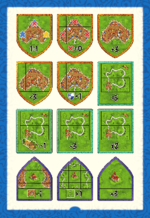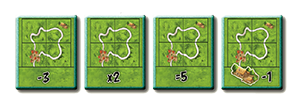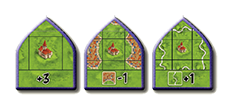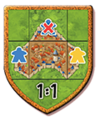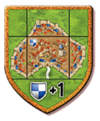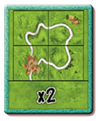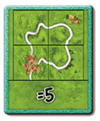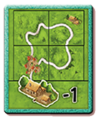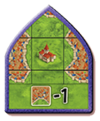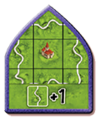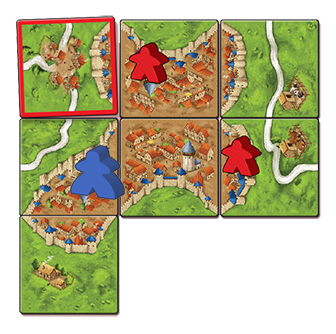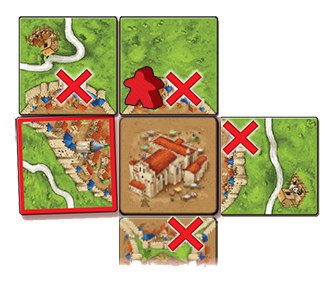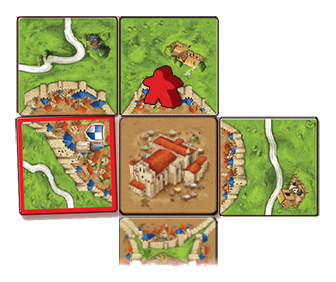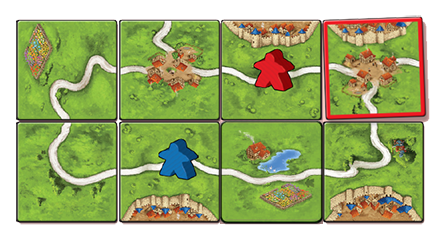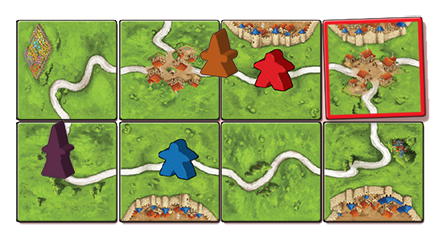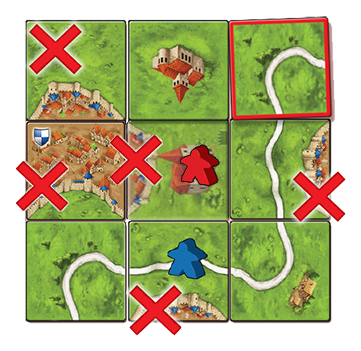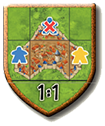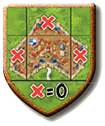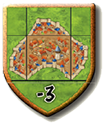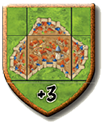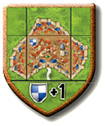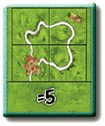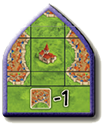The Land Surveyors
 |
You are reading the rules for this tile design. |
| If your tiles have a different design, then choose a game from Spin-offs. |  |
In this mini expansion land surveyors move throughout the Carcassonne area, redetermining its value over and over. Timing is everything as you plan and wait for the right time to score your features.
General info and comments
The Land Surveyors is the second official Print & Play mini expansion for the 2nd edition. It was released by Hans im Glück in 2020.
This expansion does not include new land tiles but a set of scoring tiles that modify the usual rules for scoring roads, cities and monasteries.
The scoring tiles are included in the last page of the rulebook available here:
- English version:
- German version:
Make sure to print out the scoring tiles onto thick paper (or glue the paper to a piece of cardboard) and cut them out.
This expansion has been developed for the Carcassonne basic game. All the basic game rules still apply in addition to the expansion rules below. You can combine it with other expansions - but at your own risk – that is, there will be no official rules for these combinations, since this has not yet been tested.
Contents
- 12 Scoring tiles divided into:
- 5 city scorings
- 4 road scorings
- 3 monastery scorings
Rules
Preparation
Divide the Scoring tiles into three stacks [1] (cities, roads and monasteries), the top side with the information facing up. Shuffle each of the three stacks and place them next to each other under the scoring board. Next, take the upper tile of each stack and place it next to the stack. Those three tiles are the active scoring tiles.
Gameplay
This expansion only affects the scoring. You will conduct the following steps: 1. Placing a tile and 2. Placing a meeple as usual.
3. Scoring a feature
For each of the three features (cities, roads and monasteries) one scoring tile is always activated. During the scoring of a feature, the scoring tiles determine, how many points a player receives. If you score more than one feature during a turn, all of those scorings are being influenced by their respective scoring tile.
After a turn in which you scored at least one feature, take all active scoring tiles and put them underneath the respective stack. After that, take the upper tile of each of the three stacks and put it next to the stack (becoming the active scoring tile). If you complete a feature, but no points are being scored (because it has no meeple on it), the active scoring tiles remain and are not being replaced.
The scoring tiles in detail
![]() Question: What are farmhouses and sheds?
Question: What are farmhouses and sheds?
Answer: They are small illustration you can find in Carcassonne II fields:
Note: The small illustrations of a cowshed, a pigsty and a donkey stable are collectively referred to as sheds or stables.
Final Scoring
Scoring tiles do not affect the scoring after the game. [6]
Other expansions
This section contains additional information about the interactions with other Carcassonne expansions.
The rules of this mini expansion only consider the features in the basic game. Moreover, the original intent is to modify the basic rules applied to majority and to feature scoring in a dynamic way. As a consequence, some individual tiles may score differently, or even the feature total score may be altered.
This said, we include the following clarifications when combining this mini expansion with other expansions in the absence of further clarifications by the publisher.
General comments
![]() The following scoring tiles should be applied first when scoring a feature in order to stick to the original intent of modifying the basic feature scoring. This means that the scoring tiles listed next should be applied before any other score modifier (such as inns and cathedrals) but not to bonuses applied on top (such as Mage or Markets of Leipzig):
The following scoring tiles should be applied first when scoring a feature in order to stick to the original intent of modifying the basic feature scoring. This means that the scoring tiles listed next should be applied before any other score modifier (such as inns and cathedrals) but not to bonuses applied on top (such as Mage or Markets of Leipzig):
- Citizens' Jury: modifies the majority on the feature. It will be considered first.
- Highway / Bad Neighborhood: modify the number of tiles to be considered during scoring. The modified tile count will be considered for any other modifier or bonus applied afterwards involving points per tile.
- Roads: German cathedrals and inns (the Mage bonus, the Markets of Leipzig's Wainwrights quarter bonus and the Bets bonus are not affected, so they use the original tile count)
- Cities: Cathars / Siege / Besiegers and cathedrals (the Mage bonus and the Bets bonus are not affected, so they use the original tile count). [7]
- Siege / Street Fair / Peasant Uprising / Hermit Monastery / Pilgrimage Route: modify the number of points scored per tile or symbol. Any modifier or bonus will be applied afterwards as usual.
![]() The following scoring tiles should be applied along with other feature bonus (such as little buildings), since they modify the points a feature is worth once the scoring per tile is done:
The following scoring tiles should be applied along with other feature bonus (such as little buildings), since they modify the points a feature is worth once the scoring per tile is done:
- Wealth / Poverty: provide a bonus or a penalty on top of the usual number of points for the feature.
![]() The monastery scoring tiles should apply to all monastic buildings: monasteries, abbeys, shrines, German monasteries, Dutch & Belgian monasteries, Japanese buildings, Darmstadt churches. German cathedrals or gardens are not considered.
The monastery scoring tiles should apply to all monastic buildings: monasteries, abbeys, shrines, German monasteries, Dutch & Belgian monasteries, Japanese buildings, Darmstadt churches. German cathedrals or gardens are not considered.
![]() An abbot meeple placed on a monastic building will not be affected by any monastery scoring tile when removed and scored early in phase 2. Placing a meeple, since the feature is not scored after completion in phase 3. Scoring a feature.
An abbot meeple placed on a monastic building will not be affected by any monastery scoring tile when removed and scored early in phase 2. Placing a meeple, since the feature is not scored after completion in phase 3. Scoring a feature.
![]() The scoring tiles must change at the end of any part of a double turn in which at least a road, a city or a monastic building was scored. This means that the scoring tiles may change 0, 1 or even 2 times in a double turn.
The scoring tiles must change at the end of any part of a double turn in which at least a road, a city or a monastic building was scored. This means that the scoring tiles may change 0, 1 or even 2 times in a double turn.
![]() The Citizens' Jury scoring tile will grant 1 strength to all players in a city, even if any player has a large meeple. All the players in the city will share the majority, no matter the number or strength of their meeples.
The Citizens' Jury scoring tile will grant 1 strength to all players in a city, even if any player has a large meeple. All the players in the city will share the majority, no matter the number or strength of their meeples.
![]() The Citizens' Jury scoring tile will grant 1 strength to all players in a city. It is irrelevant if the player has a mayor in a city with zero or several coats of arms. All the players in the city will share the majority, no matter the number or strength of their meeples.
The Citizens' Jury scoring tile will grant 1 strength to all players in a city. It is irrelevant if the player has a mayor in a city with zero or several coats of arms. All the players in the city will share the majority, no matter the number or strength of their meeples.
![]() The Citizens' Jury scoring tile will grant 1 strength to all players in a city, even if any player has a meeple on a hill. All the players in the city will share the majority, no matter if any meeple in the city is on a hill.
The Citizens' Jury scoring tile will grant 1 strength to all players in a city, even if any player has a meeple on a hill. All the players in the city will share the majority, no matter if any meeple in the city is on a hill.
![]() The Bad Neighborhood scoring tile will not consider the semicircular city segments when scoring a city with a cathedral.
The Bad Neighborhood scoring tile will not consider the semicircular city segments when scoring a city with a cathedral.
![]() Exp. 11 - Ghosts, Castles & Cemeteries
Exp. 11 - Ghosts, Castles & Cemeteries
![]() The Bad Neighborhood scoring tile will not consider the semicircular city segments when scoring a city. Ghosts assigned to meeples may lead to negative scores.
The Bad Neighborhood scoring tile will not consider the semicircular city segments when scoring a city. Ghosts assigned to meeples may lead to negative scores.
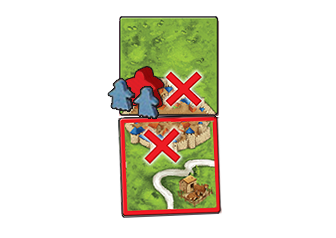 Example 3: You have completed a city. Due to the Bad Neighborhood scoring tile, the city is worth 0 points ( (2 tiles - 2 bad neighborhood tiles) x 2 points = 0 x 2 points). The 2 ghosts next to their meeple will cause Red to score -4 points (0 points for the city - (2 ghosts x 2 points) = 0 - 4 points). The scoring tile diminished the tile count but the red meeple and the ghosts added to it on the semicircular city segment are considered as usual.
Example 3: You have completed a city. Due to the Bad Neighborhood scoring tile, the city is worth 0 points ( (2 tiles - 2 bad neighborhood tiles) x 2 points = 0 x 2 points). The 2 ghosts next to their meeple will cause Red to score -4 points (0 points for the city - (2 ghosts x 2 points) = 0 - 4 points). The scoring tile diminished the tile count but the red meeple and the ghosts added to it on the semicircular city segment are considered as usual.
![]() The Bad Neighborhood scoring tile will not affect the tile count for the Mage in a city. It is irrelevant if the Mage is placed on a semicircular city segment.
The Bad Neighborhood scoring tile will not affect the tile count for the Mage in a city. It is irrelevant if the Mage is placed on a semicircular city segment.
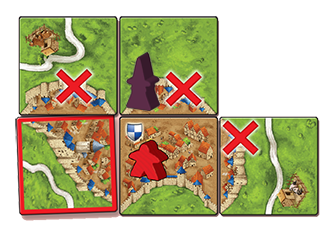 Example 4: You have completed a city. Due to the Bad Neighborhood scoring tile, the city is worth 6 points ( (5 tiles - 3 bad neighborhood tiles + 1 coat of arms) x 2 points = 3 x 2 points). Additionally, the Mage will grant 1 point per tile as usual, unaffected by the scoring tile. Therefore, Red will score 11 points for the city (6 points for the city itself + 5 points for the Mage).
Example 4: You have completed a city. Due to the Bad Neighborhood scoring tile, the city is worth 6 points ( (5 tiles - 3 bad neighborhood tiles + 1 coat of arms) x 2 points = 3 x 2 points). Additionally, the Mage will grant 1 point per tile as usual, unaffected by the scoring tile. Therefore, Red will score 11 points for the city (6 points for the city itself + 5 points for the Mage).
![]() A German castle will grant its bonus to a completed city even if the Bad Neighborhood scoring tile does not consider the semicircular city segment on the German castle tile for the city scoring.
A German castle will grant its bonus to a completed city even if the Bad Neighborhood scoring tile does not consider the semicircular city segment on the German castle tile for the city scoring.
![]() A watchtower will grant its bonus when a city on it is completed even if the Bad Neighborhood scoring tile does not consider the semicircular city segment on the watchtower tile for the city scoring.
A watchtower will grant its bonus when a city on it is completed even if the Bad Neighborhood scoring tile does not consider the semicircular city segment on the watchtower tile for the city scoring.
![]() A bet on a city will consider the tiles with semicircular city segments as usual, unaffected by the Bad Neighborhood scoring tile.
A bet on a city will consider the tiles with semicircular city segments as usual, unaffected by the Bad Neighborhood scoring tile.
![]() The Bad Neighborhood scoring tile will not consider the semicircular city segments when scoring a city with a Cathars tile.
The Bad Neighborhood scoring tile will not consider the semicircular city segments when scoring a city with a Cathars tile.
![]() The Bad Neighborhood scoring tile will not consider the semicircular city segments when scoring a city with a siege.
The Bad Neighborhood scoring tile will not consider the semicircular city segments when scoring a city with a siege.
![]() The Bad Neighborhood scoring tile will not consider the semicircular city segments when scoring a besieged city.
The Bad Neighborhood scoring tile will not consider the semicircular city segments when scoring a besieged city.
![]() A little building on a tile with a semicircular city segment will be scored as usual, unaffected by the Bad Neighborhood scoring tile.
A little building on a tile with a semicircular city segment will be scored as usual, unaffected by the Bad Neighborhood scoring tile.
![]() The removal and scoring of an abbot will not be affected by the Wealth scoring tile for monastic buildings.
The removal and scoring of an abbot will not be affected by the Wealth scoring tile for monastic buildings.
![]() The points provided by the Wealth / Poverty scoring tile to roads and cities are added after the Witch.
The points provided by the Wealth / Poverty scoring tile to roads and cities are added after the Witch.
![]() The Street Fair scoring tile will grant you one additional point per tile also with a inn. The scoring tile will double the basic value per road tile, and the additional value for an inn will be added on top.
The Street Fair scoring tile will grant you one additional point per tile also with a inn. The scoring tile will double the basic value per road tile, and the additional value for an inn will be added on top.
![]() The Highway scoring tile will not affect the number of road tiles considered by the Mage. The Witch will halve the points of the road as usual.
The Highway scoring tile will not affect the number of road tiles considered by the Mage. The Witch will halve the points of the road as usual.
![]() The Highway scoring tile will not affect the road tile count when scoring a completed German cathedral. The German cathedral will consider the usual tile count for each road connected to it.
The Highway scoring tile will not affect the road tile count when scoring a completed German cathedral. The German cathedral will consider the usual tile count for each road connected to it.
![]() The Highway scoring tile will affect the tile count when scoring a completed road with a German cathedral.
The Highway scoring tile will affect the tile count when scoring a completed road with a German cathedral.
![]() The Wainwrights quarter bonus will consider the usual road tile count, unaffected by the Highway scoring tile.
The Wainwrights quarter bonus will consider the usual road tile count, unaffected by the Highway scoring tile.
![]() A bet on a road will consider the usual tile count, unaffected by the Highway scoring tile.
A bet on a road will consider the usual tile count, unaffected by the Highway scoring tile.
![]() The Peasant Uprising scoring tile will not affect the points granted by the Mage on a road. It is irrelevant if the road includes tiles with farmhouses and even if the Mage is placed on one of them.
The Peasant Uprising scoring tile will not affect the points granted by the Mage on a road. It is irrelevant if the road includes tiles with farmhouses and even if the Mage is placed on one of them.
 Example 10: You have completed a road. Due to the Peasant Uprising scoring tile, the road is worth 4 points ( (6 tiles x 1 point) - (2 tiles with a farmhouse x 1 point) = 6 - 2 points). Additionally, the Mage will grant 1 point per tile as usual, unhindered by tiles with farmhouses. Therefore, Red will score 10 points for the road (4 points for the road itself + 6 points for the Mage).
Example 10: You have completed a road. Due to the Peasant Uprising scoring tile, the road is worth 4 points ( (6 tiles x 1 point) - (2 tiles with a farmhouse x 1 point) = 6 - 2 points). Additionally, the Mage will grant 1 point per tile as usual, unhindered by tiles with farmhouses. Therefore, Red will score 10 points for the road (4 points for the road itself + 6 points for the Mage).
![]() The Witch will be applied after inns and the Peasant Uprising scoring tile.
The Witch will be applied after inns and the Peasant Uprising scoring tile.
 Example 11: You have completed a road. Due to the Peasant Uprising scoring tile, the road is worth 10 points ( (6 tiles x 2 points) - (2 tiles with a farmhouse x 1 point) = 12 - 2 points). Additionally, the Witch on the road will halve the value of the road (rounded up if necessary). Therefore, Red will score 5 points for the road (10 points / 2 for the Witch).
Example 11: You have completed a road. Due to the Peasant Uprising scoring tile, the road is worth 10 points ( (6 tiles x 2 points) - (2 tiles with a farmhouse x 1 point) = 12 - 2 points). Additionally, the Witch on the road will halve the value of the road (rounded up if necessary). Therefore, Red will score 5 points for the road (10 points / 2 for the Witch).
![]() The Peasant Uprising scoring tile will not affect the scoring of a completed German cathedral. Tiles with farmhouses do not affect the points scored for each road connected to the German cathedral.
The Peasant Uprising scoring tile will not affect the scoring of a completed German cathedral. Tiles with farmhouses do not affect the points scored for each road connected to the German cathedral.
![]() The Peasant Uprising scoring tile will affect the scoring of a completed road with a German cathedral.
The Peasant Uprising scoring tile will affect the scoring of a completed road with a German cathedral.
![]() A little building on a tile with a farmhouse will be scored as usual, unaffected by the Peasant Uprising scoring tile.
A little building on a tile with a farmhouse will be scored as usual, unaffected by the Peasant Uprising scoring tile.
![]() The Hermit Monastery scoring tile will grant one point less per tile with a city segment involved in the scoring of a completed monastic building. The base game does not feature city segments on monastery tiles, but this may happen in some expansions.
The Hermit Monastery scoring tile will grant one point less per tile with a city segment involved in the scoring of a completed monastic building. The base game does not feature city segments on monastery tiles, but this may happen in some expansions.
![]() The removal and scoring of an abbot will not be affected by the Hermit Monastery scoring tile.
The removal and scoring of an abbot will not be affected by the Hermit Monastery scoring tile.
![]() A vineyard will grant its bonus to a neighboring monastic building as usual, even if the vineyard is on a tile with a city segment. The Hermit Monastery scoring tile does not affect vineyards.
A vineyard will grant its bonus to a neighboring monastic building as usual, even if the vineyard is on a tile with a city segment. The Hermit Monastery scoring tile does not affect vineyards.
![]() The removal and scoring of an abbot will not be affected by the Pilgrimage Route scoring tile.
The removal and scoring of an abbot will not be affected by the Pilgrimage Route scoring tile.
![]() A vineyard will grant its bonus to a neighboring monastic building as usual, even if the vineyard is on a tile with a road segment. The Pilgrimage Route scoring tile does not affect vineyards.
A vineyard will grant its bonus to a neighboring monastic building as usual, even if the vineyard is on a tile with a road segment. The Pilgrimage Route scoring tile does not affect vineyards.
Tile distribution
Total Scoring Tiles: 12
Footnotes
For Icons explanation and licensing please visit Icons page.
- ↑
 The rules by HiG used the word "pile." Instead, we used "stack" for the sake of consistency with other rules in English.
The rules by HiG used the word "pile." Instead, we used "stack" for the sake of consistency with other rules in English.
- ↑
 The Bad Neighborhood scoring tile affects tile count. The meeples placed on those tiles not counted for the scoring are still considered for the majority as usual.
The Bad Neighborhood scoring tile affects tile count. The meeples placed on those tiles not counted for the scoring are still considered for the majority as usual.
- ↑
 The Street Fair scoring tile shows a "x2" instead of presenting a generic road tile followed by "+1". The latter format is preferred in those scoring tiles with modifications applied to certain tiles only. However, the "x2" format is more straightforward to indicate the "+1" point affects all the tiles.
The Street Fair scoring tile shows a "x2" instead of presenting a generic road tile followed by "+1". The latter format is preferred in those scoring tiles with modifications applied to certain tiles only. However, the "x2" format is more straightforward to indicate the "+1" point affects all the tiles.
- ↑
 The Highway scoring tile affects tile count. No matter the length of the road, it will be scored as a 5-tile road. This scoring tile has a dual behavior as it can increase or decrease the actual scoring for a road.
The Highway scoring tile affects tile count. No matter the length of the road, it will be scored as a 5-tile road. This scoring tile has a dual behavior as it can increase or decrease the actual scoring for a road.
- ↑
 The rules by HiG used the word "stable." Instead, we used "shed" for the sake of consistency with other rules in English.
The rules by HiG used the word "stable." Instead, we used "shed" for the sake of consistency with other rules in English.
- ↑
 The rules do not mention the final scoring explicitly but the rules only mention the scoring of completed features during players' turns.
The rules do not mention the final scoring explicitly but the rules only mention the scoring of completed features during players' turns.
- ↑
 Those tiles not considered for the tile count for the basic scoring the city will be considered as usual for bonus scorings such as German cathedral bonuses or triggering the scoring of neighboring castles. Any figures or tokens placed on those tiles will be considered as usual: meeples, special figures, neutral figures and tokens such as little buildings.
Those tiles not considered for the tile count for the basic scoring the city will be considered as usual for bonus scorings such as German cathedral bonuses or triggering the scoring of neighboring castles. Any figures or tokens placed on those tiles will be considered as usual: meeples, special figures, neutral figures and tokens such as little buildings.
